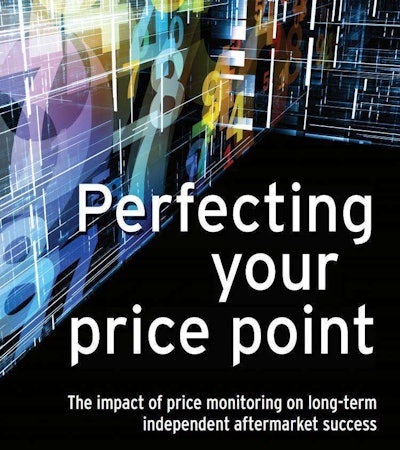The following comes from the March 2016 issue of Truck Parts & Service. To read a digital version of the magazine, please click the image below.

A profitable business is defined by its bottom line.
But business owners who strive for more than just keeping the doors open, must also direct equal attention toward the top line.
Business growth and expansion opportunities all stem from increased revenue generation.
And while there are endless business strategies that can be implemented to increase top line potential, no action has a more direct impact than price modification.
Pricing in the independent aftermarket is an endless task. With new products entering the industry each day and purchasing costs changing regularly, aftermarket distributors looking to perfect pricing require an innate knowledge of their business, customers and overall marketplace. Set prices too high and you risk turning away good customers.
Set them too low and your gross profit margin might not increase enough to allow your business to grow.
The key is finding a middle ground that works for your business and your customers alike, which begins the instant you take on a new product line.
You can’t determine what retail price is best for a product until you know how much you’re paying for it. This is done by determining the funds required to purchase and ship products to your facility.
In the aftermarket, purchasing components in bulk can lower per unit procurement costs for most products, but large, heavy components will still incur substantial acquisition costs. Failing to properly factor these expenses into your true cost of a product can be devastating.
“You can price yourself right out of a market,” says Paul Reynolds, product owner at Karmak.
Once investment expenses are finalized, you can begin calculations on your retail price.
This should be done using a formula that multiplies your investment in the component against an optimal gross profit margin percentage to determine an ideal retail price. (Distributors using a pricing matrix should perform these calculations separately for each customer group.)
Gross profit margin expectations should not be identical for all products — some product lines demand lower margins while others offer substantial margins gains — but should function within the context of your inventory to help achieve your overall profit margin goal.
“Margins are going to vary by part numbers, product lines and brands,” says Don Purcell, partner at Stone Truck Parts. “They are not ever all going to be the same.”
And don’t forget about hidden costs.
There are unintended and unforeseen expenses related to every product you sell. These costs can develop through operational inefficiencies, such as poor inventory management or unproductive delivery routes, as well as employee miscues, customer misunderstandings and disorganization. Typically unquantifiable until they are removed, these productivity inhibitors can slice revenue from your net sales and net income.
All retail prices should be set at points that allow gross profit margin to cover inventory expenses, known operational expenses and estimated hidden costs while still providing opportunity for healthy net profit.
“We have target numbers for different product groups and try to hit those targets as much as we can,” says Frank Szabo, president at Ohio Diesel Fleet Supply. “We know what it costs to run our operation, and we try to keep our costs in control so our prices can be responsive within our market.”
The best route to competitive prices is operational efficiency, says Dan Straszewski, president at CLF Warehouse, Inc.
“You have to become more efficient within your operation. That’s just a fact. You must have the least amount of overhead possible,” he says.
While no step in pricing is as mathematically stimulating as new product pricing, the nuance and expertise required to manage price has a much larger impact on the overall profitability of a distributorship.
Pricing management requires the ability to evaluate data and market trends concurrently. It requires the ability to decipher the difference between a seasonal sales dip and a long-term slide, the skill to uncover hidden costs and tweak prices accordingly.
Managing price demands critical thinking skills, and the intelligence to know when changes should, and should not, be made.
“Price strategy is not a short-term thing,” says Bill Wade of Wade & Partners. “Your price is part of what you stand for. It’s not something you can jerk around.”
Wade says one trap distributors must avoid when managing price is becoming victims of their own knowledge.
Customers don’t know what you pay for your parts, nor do they know how much it costs you to sell them. Don’t let what you know about your finances impact how a customer views your price, Wade says.
“You set your price based on your margins and what you need to make,” he says. Wade says this is especially important in situations where a competitor has a lower price. “Just because you find a cheaper price in the market doesn’t mean everyone has found it, and that everyone will jump on it,” he says. “[Customers] might not even know there’s a bargain out there.”
And even if customers do find the price, Wade says that’s no guarantee that they’ll leave your business just to snag the cheaper rate. Not every customer buys exclusively on price. Most customers who value comprehensive service will accept a higher price when it comes with great service.
“Not everyone wants to be the low-dollar purchaser,” Szabo says. “There are customers out there that value our service, our product knowledge, our payment structure … they value our company and are willing to pay for what we provide.”
In some cases lowering prices can even be met with customer skepticism, Wade says.
“You don’t want customers to start questioning the decision, to start wondering if your supplier has substituted raw materials,” he says. “And you don’t want to be known as a business that jerks around your prices.”
Setting prices solely to acquire market share is another move Wade says distributors are best to avoid. He says cutting or capping a price to become your market’s lowest-cost distributor nets you the exact type of customer who’s looking for the lowest-cost distributor.
And those customers don’t last.
“Do you think when you raise your price you’ll be able to keep them?” he says.
Steady pricing provides a much better environment for developing long-term customer relationships. Such stability in the face of lower cost competition also ensures you remain in control of your revenue.
“Never be the guy who gets mad at the other distributors in the market who are always cutting price, and then does the same thing to keep up,” Wade says. “When you do that you let someone you have no respect for run your business.”
Which isn’t to say there’s never a good point to cut price.
Lowering rates on seasonal items or obsolescent parts is a good way to eliminate dead inventory and free up space for more components with higher profit potential, says Straszewski. As are sales on high-moving products that require additional, higher margin related components.
“Maybe you put an airbag on sale because you know the people who are looking for an airbag also will need shocks,” he says.
The key is moderation. Net sales and gross profit do not grow at the same rate, and slicing a price to move more parts doesn’t always result in a better bottom line.
 Karmak’s business system includes a pricing matrix feature that allows distributors to determine customer and price groups
Karmak’s business system includes a pricing matrix feature that allows distributors to determine customer and price groupsEspecially not when offered to everyone.
This is where a pricing matrix comes in handy. By categorizing customers within a matrix and determining your operational expenses in serving each group, Reynolds says distributors can build a matrix that clearly identifies product lines where multiple retail prices can be offered without risking gross profit.
“A matrix can be as complex or simple as a [distributor] wants it to be. It really is up to them and how they want to break down their customer base,” he says.
Szabo says he checks his price matrix almost daily, and makes sure to review it after any vendor price change and in situations where the retail market appears to be shifting. This ensures Ohio Diesel Fleet Supply’s prices remain in line with its internal and external goals at all times.
Reynolds advises all distributors to do the same, and says Karmak offers training to guide distributors through regular matrix restructuring to ensure their prices remain optimal.
“We try to show them ‘This is where your prices are now, and if you restructure your matrix this is where you are going to be,’” he says.
“Pricing is an art, not a science. You have to monitor it every day,” Straszewski says.
Adjustments that move prices higher require careful consideration and tact. Wade says good customers are accepting of higher prices when they are introduced through balanced, incremental increases. It’s when numbers swing wildly that customers start to recoil.
“Customers know prices have to go up sometimes,” he says. “One percent is there for you all day. You could go into your computer system at night and raise your prices 1 percent across the board and nobody would notice except for your accountant.”
And in cases where customers do speak up about higher prices, Wade says don’t be annoyed. A customer who attempts to work with you when your price is high or alerts you to a better deal across town is a customer to be cherished, because that’s a person who would rather have a difficult conversation with you than go somewhere else.
“I always tell my customers ‘Don’t be afraid to come ask me. The worst I can do is say no,’” says Szabo.
But Wade adds that in those situations a discount shouldn’t reflexively be given as a reward, it should be given if market research proves your price is out of line. Being a premium aftermarket supplier means you’re rarely going to be your customer’s cheapest option, and customers should know that.
“Your goal should not be to always get the last sale, your goal should be to always get the last look,” Wade says.
Purcell says Stone Truck Parts focuses on value and product quality when conveying that message to its customers.
“We don’t sell private labels; we sell OEM first-fit parts and when we go to a customer we sell them on that,” he says. “We try to educate the customer that you want to put back on the truck what came off the truck to maximize performance.”
In cases where a customer still balks or is hesitant, Szabo, Straszewski and Purcell all say they’ve given their sales people authority to temporarily adjust prices to make a sale.
“We do allow them to make those decisions but we tell them to make sure they are comparing apples to apples and that [the prices] are for likewise components,” Purcell says.
And each distributor monitors these exceptions on a daily basis to ensure pricing overrides aren’t overused.
Exception pricing is so named for a reason, says Szabo. “If you find out you’re out of line that’s one thing. It shouldn’t be something you need to do all of the time.”











